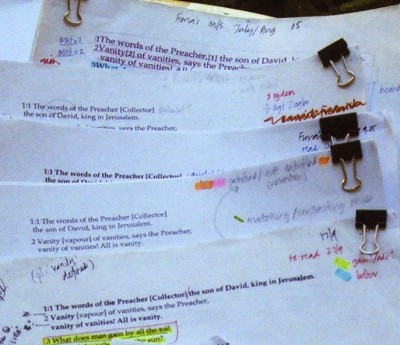Reading the texts by “Manuscript Discovery”
I began work on all five of The Scrolls by reading them carefully both individually and in a group, using the Manuscript Discovery (MD) method. At the 1976 National Conference of the Australian Fellowship of Evangelical Students, the then General Secretary Tony McCarthy inspired us to read Mark’s Gospel, using MD. It was as if we were discovering it for the first time. The experience was life-changing for me. I think Tony learnt it from Frank Anderson, who had been introduced to it by their associated American InterVarsity Christian Fellowship staff.
Year later, we found a copy of Jack Kuhatschek’s small booklet How to study the Bible (1985 InterVarsity Press Illinois) that describes the method. My husband Ross wrote to the American IVF asking about its origin and development, and received a comprehensive reply from staffworker Paul Byer, who began developing the idea with Christian students around 1953-4. He sent us an article written by Stan Slade in the mid 90s about the impact of using this “inductive Bible study” method in El Salvadore.
We ran many camps for teenagers and adults teaching this method, and over the years, they have gone on to use and teach it in their own styles. And so today it has many variations.
In the MD approach, the whole text being studied is set out as a “manuscript” to reflect its original format. That is, it is printed without chapter or verse references or divisions, or other editorial additions such as sub-headings. If poetry, then it is set out in its lines, but without other spacing. If any other kind of literature, our manuscript contains a continuous flow of sentences, without paragraphs or other divisions. In both, only page and line numbers are shown, and enough space around the text to allow study notes. Participants are given this “manuscript” to “discover”, reading it individually and debating their findings in the group. The goal of this method is to present a literary text to a group, which considers it as a whole with the aim of exploring its structure, content and the original writer’s purposes. It begins by members individually reading straight through the text to gain a first impression of it, a second reading to build on that, and many more to gain deeper and deeper understanding, similar to an archaeological dig from the surface down. At each stage, findings are discussed in the group. By the end of the study, the manuscripts are scribbled over, highlighted in multi-colours as themes are traced throughout, and structures suggested. In this way, discoveries are “owned”, and the text becomes a known friend.
This first-hand MD study of each text forms the foundation of each illuminated manuscript. In fact, although my research deepened my understanding, this initial work gave me a very good working knowledge of each text. Although I undertook much of this work on my own, I also discussed it in a weekly MD Bible study group, which formed a sounding board for my ideas.
MD has been my Bible study method for 35 years. I’ve used it in my own studies, home groups and several-day retreats. For one of these, I wrote a handout that I show below. You could check out what Paul Byer, Jack Kuhatschek, Stan Slade and others may have written to explain it. I hope one day there will be a comprehensive manual.

Ecclesiastes Manuscript
If you wish to download the MD booklet, please do so here: Manuscript Discovery Booklet
If you are in a church or group who would like to explore a portion of the Bible in a Manuscript Discovery workshop, contact me.


